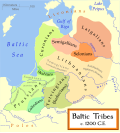Lithuanian language
The Lithuanian language is a Baltic language. It is from Lithuania, spoken in a few countries in Europe, as well as in the Americas and Australia.
| Lithuanian | ||||
|---|---|---|---|---|
| lietuvių kalba | ||||
| Native to | Lithuania | |||
| Region | Europe | |||
| Native speakers | 2.96 million (Lithuania) 170,000 (Abroad) 3.13 million (Worldwide)[1] (date missing) | |||
| Language family | ||||
| Dialects | ||||
| Writing system | Roman script | |||
| Official status | ||||
| Official language in | ||||
| Recognised minority language in | ||||
| Regulated by | Commission of the Lithuanian Language | |||
| Language codes | ||||
| ISO 639-1 | lt | |||
| ISO 639-2 | lit | |||
| ISO 639-3 | lit | |||
| Linguasphere | 54-AAA-a | |||
| ||||
Lithuanian and Latvian are the only remaining Baltic languages. Both languages have much in common. Lithuanian, however, adopted fewer words and phrases from German and other languages. However, many words were adopted into Lithuanian by Slavic languages long ago, but in 1920, the Lithuanian philologist Jonas Jablonskis and others replaced them with native Lithuanian words.

There are two main dialects of Lithuanian. Samogitian is used mostly in West Lithuania, and the other that is widely used in the whole country is Aukštaitian (Highlanders' dialect). Standard Lithuanian comes from West Aukštaitian.
The first book written in Lithuanian is Katekizmas by Martynas Mažvydas. It was published in East Prussia in 1547.
Even though Lithuanian was written down relatively recently, it is known for being close to old Proto-European languages by keeping old traits that are found only in early languages like Vedic Sanskrit and have been lost in later languages.
Lithuanian Language Media
The Grand Duke of Lithuania, Alexander Jagiellon, specified that the Roman Catholic priests in these 28 churches must know the Lithuanian language, according to his letter of 18 September 1501, which was addressed to the Bishop of Vilnius Albertas.
The oldest surviving manuscript in Lithuanian (c. 1503), rewritten from a 15th century original text.
A map of European languages (1741) with the first verse of the Lord's Prayer in Lithuanian
A woman speaking in Lithuanian
References
| This language has its own Wikipedia project. See the Lithuanian language edition. |






